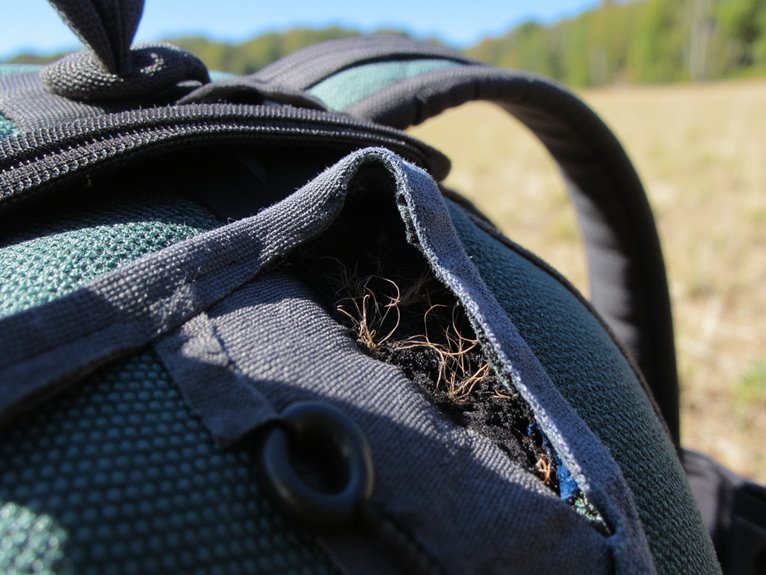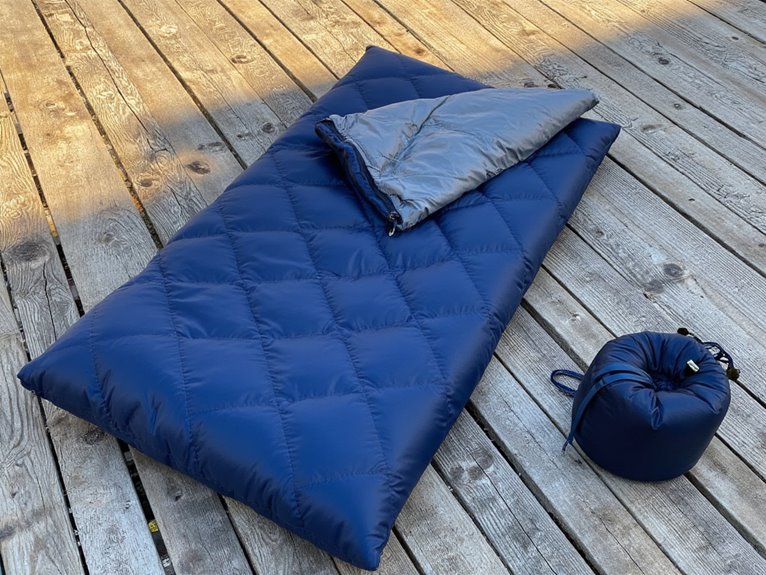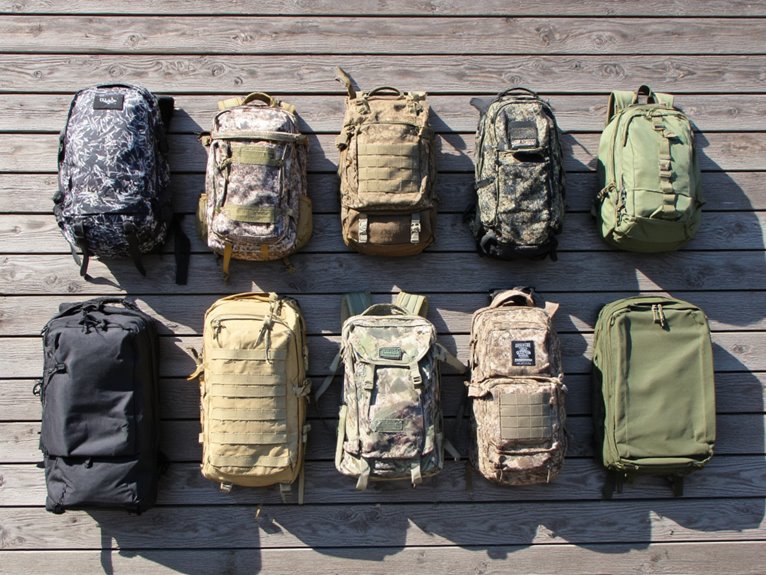Backpack Delamination: Preventing and Fixing Fabric Separation
Backpack delamination occurs when adhesive bonds between fabric layers fail, causing bubbling, wrinkling, and crunchy sounds that compromise waterproof protection. You’ll face replacement costs of $200-$400 for high-performance packs versus $50-$100 for standard models. Temperature fluctuations, UV exposure, and humidity accelerate adhesive breakdown through micro-stresses and hydrolysis reactions. Prevent damage by storing indoors, applying UV protection sprays, and maintaining proper ventilation. DIY repairs involve cleaning with rubbing alcohol and applying specialized adhesive patches, though professional services guarantee warranty preservation and proper material compatibility for thorough restoration techniques.
We are supported by our audience. When you purchase through links on our site, we may earn an affiliate commission, at no extra cost for you. Learn more. Last update on 7th January 2026 / Images from Amazon Product Advertising API.
Notable Insights
- Delamination causes fabric layers to separate, creating bubbling, wrinkling, and crunchy sounds that compromise backpack structural integrity.
- Store backpacks indoors away from UV light, ensure complete drying before storage, and use breathable cotton bags.
- Clean delaminated areas with rubbing alcohol, apply specialized adhesive patches, and use water-resistant treatments for DIY repairs.
- Avoid temperature fluctuations and high humidity which weaken adhesive bonds and accelerate fabric layer separation over time.
- Professional repairs cost $30-50 and are recommended for multiple layer damage, waterproof zippers, and high-value gear restoration.
What Is Backpack Delamination and Why Does It Happen?
When you notice your backpack’s outer shell starting to bubble, wrinkle, or make crunchy sounds under pressure, you’re witnessing delamination-the separation of bonded material layers that compromises your pack’s structural integrity and performance.
Modern backpacks rely on laminated fabrics and coated textiles for water resistance and durability. These materials consist of multiple layers bonded with polymer adhesives.
Delamination causes include manufacturing defects like insufficient adhesive or trapped air during production. Mechanical stress from repeated flexing, overloading, or impact creates bond failures at the adhesive-fabric interface.
Environmental factors accelerate deterioration. UV radiation from prolonged sun exposure breaks down the polymer bonds between fabric layers, weakening the laminated structure.
Temperature extremes cause layers to expand at different rates, straining connections. Moisture exposure degrades adhesives over time. Surface contamination from dirt or oils creates weak bonding zones that compromise fabric integrity, reducing load-bearing capacity and weather protection. The failure typically begins with adhesion loss between the fabric layers, similar to how delamination occurs in other layered materials.
The Hidden Costs of Fabric Layer Separation

Although delamination appears as a simple cosmetic issue, it triggers cascading financial consequences that extend far beyond the initial fabric failure. You’ll face replacement costs averaging $200-400 for high-performance laminated backpacks versus $50-100 for standard nylon models. Specialized repair services charge premium rates for delamination fixes that exceed typical DIY capabilities.
| Cost Category | Standard Backpack | Laminated Backpack |
|---|---|---|
| Replacement | $50-100 | $200-400 |
| Repair Service | $15-25 | $40-75 |
| Downtime Loss | 1-2 days | 3-7 days |
| Warranty Coverage | 80% covered | 40% covered |
| Lifespan Reduction | 10-15% | 25-40% |
Fabric longevity decreases remarkably when delamination compromises structural integrity. User experiences reveal that insurance rarely covers fabric separation, forcing out-of-pocket expenses. You’ll also encounter operational downtime that disrupts planned activities and reduces gear reliability when you need it most. Budget-friendly options often provide comparable performance without the delamination risks associated with premium laminated fabrics. Modern fabrics like Ultraweave and UltraTNT demonstrate superior resistance to layer separation compared to traditional laminated materials.
How Environmental Factors Accelerate Material Breakdown
Your backpack’s fabric layers face constant assault from environmental forces that systematically weaken the bonds holding them together.
Temperature swings cause materials to expand and contract at different rates, creating micro-stresses at adhesive interfaces, while humidity penetrates fabric fibers and promotes mold growth that degrades organic components.
UV radiation breaks down chemical bonds in synthetic materials like nylon and polyester, causing surface cracking and brittleness that accelerates delamination under normal use conditions. Backpacks with PU coatings experience reduced breathability in humid environments, trapping moisture that further compromises the adhesive layers between fabric and coating.
Anti-microbial coatings containing silver ion or zinc pyrithione can help protect against bacterial breakdown, but these protective treatments may wear away with repeated exposure to harsh conditions.
Temperature and Humidity Effects
Environmental conditions act as silent accelerants in backpack delamination, with temperature and humidity creating a destructive partnership that systematically breaks down the adhesive bonds holding fabric layers together.
Temperature impact proves devastating to adhesive integrity. Elevated temperatures accelerate polymeric adhesive breakdown, causing expansion and softening that compromises cohesive strength. Heat cycles create mechanical stresses that propagate micro-cracks at layer interfaces.
Poor curing temperatures during manufacturing reduce crosslinking density, making your backpack vulnerable to thermal degradation. Insufficient aging time after the lamination process can result in weak adhesive bonds that fail under environmental stress.
Moisture influence compounds these problems considerably. Humidity causes adhesive swelling, weakening interlayer bonds through hydrolysis reactions that degrade chemical connections. Residual solvents trapped in adhesive layers vaporize when heated, creating bubbles that separate fabric layers. Surface contamination during manufacturing hinders proper adhesive wetting and creates weak points susceptible to environmental degradation.
This hygrothermal exposure softens adhesives and reduces joint toughness, undermining your backpack’s structural stability.
UV and Storage Damage
While temperature and humidity work gradually, ultraviolet radiation delivers immediate and irreversible damage to your backpack’s fabric structure. UV rays break down polymer chains in nylon and polyester, reducing tensile strength by up to 50% after extended exposure. This degradation accelerates delamination as adhesive bonds weaken beneath compromised fabric layers.
Your storage choices directly impact fabric lifespan. Direct sunlight storage accelerates UV damage and laminate separation. Indoor storage in dry, shaded areas preserves materials markedly longer. Pollutants like ozone compound deterioration during storage.
Fabrics with higher UPF ratings degrade slower-Supplex® UPF40+ blocks 97.5% of harmful rays. Dark, tightly woven materials offer superior UV protection compared to light-colored alternatives. UV protection sprays create reflective barriers that extend fabric life when reapplied regularly. Advanced materials like Dyneema Composite Fabric naturally block UV rays without requiring chemical treatments due to their molecular structure. When applying protective treatments, ensure the fabric is clean and completely dry before spraying to maximize adhesion and effectiveness. Quality hiking backpacks use weather-resistant materials specifically designed to withstand prolonged environmental exposure and maintain their structural integrity.
Manufacturing Solutions for Stronger Layer Bonds
When backpack manufacturers face delamination issues, implementing targeted manufacturing solutions creates stronger, more durable layer bonds that withstand years of heavy use.
You’ll find that advanced latex binders form flexible bonds that resist mechanical stress while reducing separation risk. Manufacturers achieve ideal adhesive performance by customizing polymer composition to match specific fabric requirements.
Water-based adhesives eliminate solvent retention that weakens interlayer connections during production.
Substrate compatibility becomes critical when matching thermal expansion coefficients between materials. This prevents temperature-induced stress that causes layer failure.
Surface treatments like corona discharge increase fabric energy levels, improving bond strength considerably. Controlled lamination parameters-including precise temperature and pressure settings-ensure consistent adhesion quality.
Regular peel strength monitoring detects weak bonds before products reach consumers. Automated processes reduce human error while maintaining strict environmental controls during curing phases. High-quality manufacturers use materials like 210T polyester with advanced PU coatings that provide superior waterproof protection while maintaining strong interlayer adhesion.
Smart Storage and Care Practices for Extended Lifespan
Strong manufacturing bonds mean nothing if you don’t maintain your backpack properly between uses. Proper storage solutions begin with complete cleaning and drying.
Remove all contents and vacuum debris from every compartment. Clean according to material specifications: nylon requires mild soap and warm water, while leather needs specialized conditioners. Air dry completely before storage to prevent mold growth and adhesive breakdown.
Thorough cleaning with material-appropriate products and complete air drying prevents mold formation and preserves critical adhesive bonds.
Effective fabric care during storage involves maintaining structural integrity. Stuff your backpack with soft materials to preserve shape and prevent stress concentration at bonded seams.
Never compress or fold repeatedly, as this weakens adhesive bonds at flex points. Store in cool, dry environments using breathable cotton bags rather than plastic containers that trap moisture.
Keep zippers open for ventilation and inspect regularly for early delamination signs. Pay particular attention to waterproof zippers during inspection, as these specialized components are critical for maintaining gear protection but can be vulnerable points where delamination may first appear.
Early Warning Signs of Delamination Damage
Since delamination typically develops gradually over months or years, you’ll often miss the earliest warning signs unless you know exactly what to look for.
Effective delamination prevention starts with recognizing subtle changes in your backpack’s fabric behavior and appearance.
The most reliable early indicators include:
- Flaking or peeling surfaces on polyurethane-coated fabric areas, often appearing as small patches
- Sticky residues where coating has partially separated, leaving unpleasant tactile surfaces
- Tiny bubbles or barely visible layer separations that signal adhesive failure
You’ll also notice functional changes like reduced water resistance during light rain exposure.
Listen for crinkly sounds when handling the fabric-this indicates coating breakdown.
Proper fabric care includes regular inspections for dandruff-like detritus shedding from deteriorating coatings, particularly near seams where stress concentrates.
DIY Repair Techniques for Separated Layers
You can repair separated backpack layers effectively with three essential steps that address both immediate damage and long-term durability.
Start by thoroughly cleaning the delaminated area with rubbing alcohol and removing all loose material to create an ideal bonding surface.
Then apply specialized adhesive patches cut 1 cm larger than the damage, followed by water-resistant treatments to restore the fabric’s protective barrier and prevent future moisture infiltration.
Clean and Prepare Surface
Before applying any adhesive or patch material to delaminated backpack fabric, you’ll need to create a clean, stable surface that promotes maximum bonding strength.
Proper cleaning techniques start with removing loose flakes and debris using vacuum suction or gentle brushing. Clean the area thoroughly with isopropyl alcohol to eliminate oils and residues that prevent adhesive bonding.
Surface stability requires mechanical preparation. Lightly sand damaged areas to remove degraded coatings and create an adherent base. Feather torn edges into tapered scarf joints for improved repair strength.
Essential preparation steps include:
- Remove contaminants and old adhesive residues completely
- Cut patches 1 cm larger than damage with rounded corners
- Place firm backing under repair zone for shape support
Allow surfaces to dry completely before applying repair materials for ideal adhesion. Similar to outdoor gear like sleeping pads that utilize 40D nylon construction for enhanced durability, proper surface preparation ensures your backpack repair will withstand outdoor conditions.
Apply Waterproofing Treatments
Once the cleaned surface has dried completely, waterproofing treatments become your next line of defense against future delamination and water penetration. The waterproofing benefits include creating hydrophobic barriers that prevent moisture infiltration while maintaining fabric breathability. Apply DWR sprays from 6-8 inches away using two light coats rather than one heavy application.
| Treatment Type | Application Method | Durability |
|---|---|---|
| DWR Spray | Two light coats, 6-8″ distance | 3-6 months |
| Silicone Coating | Brush or spray application | 6-12 months |
| TPU Treatment | Professional application | 1-2 years |
| PU Coating | Factory or professional only | 2-5 years |
Treatment frequency depends on usage intensity and environmental exposure. Reapply DWR treatments after washing or every few months of heavy use to maintain ideal protection levels. Consider that waterproof treatments may deteriorate over time, and washing can significantly impact performance, requiring more frequent reapplication with sealed seams for optimal protection.
Reinforce With Adhesives
When delamination compromises the structural integrity of your backpack’s layered materials, adhesive reinforcement offers a permanent solution that restores both waterproofing and durability.
Multiple adhesive types serve different repair needs effectively. RTV silicone rubber bonds silnylon and silpoly fabrics with flexible strength. Seam Grip provides superior viscosity for waterproof materials, while fabric-specific glues maintain flexibility through repeated bending cycles.
Proper application techniques guarantee lasting repairs:
- Clean the damaged area thoroughly and prime fabric edges with a light adhesive coat
- Cut patches 2 inches larger than damage using similar fabric materials with rounded edges
- Apply thin adhesive layers, allowing 24-hour curing between applications for maximum bond strength
Insert backing material during application to prevent seepage. Cover repairs with cling wrap for compression during the curing process.
When Professional Repair Services Are Worth It
Although many backpack delamination issues can be addressed through DIY methods, professional repair services become crucial when dealing with severe structural damage, specialized materials, or high-value gear. You’ll benefit from specialized equipment like industrial sewing machines and technical expertise that guarantees proper material matching and waterproof sealing.
| Repair Scenario | Professional vs. DIY |
|---|---|
| Multiple layer delamination | Professional required |
| Waterproof zipper replacement | Professional recommended |
| High-value gear restoration | Professional essential |
| Frame structural damage | Professional only |
| Warranty preservation | Professional mandated |
Professional repair processes typically cost $30-$50 for standard repairs, considerably less than replacement costs. These repair benefits include extended gear lifespan, maintained warranty coverage, and proper material compatibility. Complex delamination involving technical fabrics requires professional material knowledge and specialized adhesives unavailable to consumers.
Warranty Claims and Replacement Options
When your backpack develops delamination, you’ll need to determine whether the damage qualifies for warranty coverage or requires out-of-pocket repair costs.
Most manufacturers exclude delamination caused by environmental exposure, improper storage, or user negligence from their warranty programs, focusing instead on manufacturing defects in materials and workmanship.
You’ll face a choice between filing a warranty claim for potential replacement, paying for professional repair services, or accepting that some delamination damage simply can’t be fixed under standard coverage terms.
Understanding Warranty Coverage
Most backpack manufacturers structure their warranty policies around a clear distinction between manufacturing defects and normal wear patterns, with delamination often falling into a gray area that requires individual assessment.
Understanding warranty eligibility requires knowing that coverage typically applies only to products purchased new from authorized dealers. Coverage limitations exclude standard wear, environmental damage, and accidental tears.
Key warranty exclusions include:
- Delamination caused by improper storage or extreme temperatures
- Damage from drops, cuts, or animal attacks
- Aesthetic issues like fading that don’t affect functionality
Companies assess each delamination case individually to determine if it represents a manufacturing defect or normal use deterioration.
Your usage patterns directly impact warranty decisions-daily use accelerates reasonable lifetime expectations compared to occasional use.
Filing Delamination Claims
Filing a warranty claim for backpack delamination requires specific documentation and follows a structured process that varies by manufacturer. You’ll need proof of purchase from an authorized dealer and clear photos showing the defect.
Most brands exclude delamination caused by weather exposure, humidity, or improper storage from coverage-these warranty exclusions greatly limit claim approval.
The claim process typically involves submitting an online form with detailed descriptions of when you discovered the damage. Response times average 3-7 business days. If approved, you’ll receive a prepaid shipping label to return the backpack.
However, delamination often falls under excluded damage since manufacturers classify it as environmental wear rather than manufacturing defects. Alternative options include paid repair services or replacement considerations.
Replacement Vs Repair
After understanding the claim approval process, you’ll face a critical decision if your warranty claim succeeds: should you repair the delaminated backpack or replace it entirely?
Repair advantages include cost savings and environmental benefits.
Professional shops can replace delaminated panels, though costs may approach your pack’s current value.
DIY repairs using GearAid Seam Grip or Nikwax re-proofing treatments offer budget-friendly solutions for minor delamination.
Replacement drawbacks involve several limitations:
- Color and fabric matches aren’t guaranteed due to stock limitations
- You’ll bear shipping costs for warranty evaluation
- Replacement eligibility depends on pack age and damage extent
High-end specialty packs justify professional repair costs, while budget models make replacement more economical.
Functional packs with cosmetic delamination can continue service with simple workarounds like trash bag liners until replacement becomes necessary.
Emerging Technologies in Delamination-Resistant Design
While traditional backpack manufacturing relies on adhesives and coatings that inevitably fail over time, breakthrough technologies are revolutionizing how fabrics resist delamination from the molecular level up.
ALUULA’s Graflyte™ fabric eliminates adhesives entirely through molecular fusion technology. This emerging technology uses 100% UHMWPE fused at the molecular level, preventing traditional peeling completely. The composite design achieves superior durability while reducing weight.
| Technology | Key Innovation | Performance Benefit |
|---|---|---|
| Molecular Fusion | UHMWPE molecular bonding | Zero delamination risk |
| Ultra X™ Fibers | 10x steel strength | Enhanced stress resistance |
| Advanced Binders | Latex formulations | Stronger layer adhesion |
| Surface Treatments | Plasma processing | Improved bonding energy |
| Grid Reinforcement | 45/135-degree fiber layers | Dimensional stability |
Innovative materials include Ultra X™ fibers offering ten times steel’s strength-to-weight ratio. These fibers integrate at specific angles under waterproof films, reducing stretch and protecting against separation.
Frequently Asked Questions
Can Delamination Affect Backpack Breathability and Ventilation Performance?
Yes, delamination greatly compromises your backpack’s breathability and ventilation performance.
When fabric construction layers separate, you’ll experience disrupted airflow patterns and reduced moisture management capabilities. The separation blocks designed ventilation pathways, causing heat and humidity to accumulate against your back.
Your body’s natural thermoregulation becomes impaired as moisture-wicking properties fail, leading to increased dampness and reduced thermal comfort during activities.
Do Different Fabric Colors Experience Delamination at Varying Rates?
You won’t find significant delamination rate differences between fabric colors.
Color durability and fabric composition matter more than hue itself. Delamination occurs when coatings fail due to moisture, abrasion, and aging-factors unrelated to color.
Black, blue, or red fabrics delaminate at similar rates when using identical coating systems.
Your fabric’s construction quality and coating type determine separation resistance, not its pigmentation.
Is Delamination More Common in Budget Backpacks Versus Premium Brands?
You’ll find delamination occurs markedly more in budget backpacks than premium brands.
Budget materials like basic nylon and weak adhesives fail under stress, while premium craftsmanship employs ripstop fabrics and advanced bonding techniques.
Backpacks under $50 prioritize cost over durability, compromising lamination quality.
Premium brands use reinforced construction and superior materials that resist fabric separation through stronger molecular integrity and stress distribution.
Can Airplane Cargo Hold Pressure Changes Cause or Accelerate Delamination?
Cargo pressure changes can accelerate delamination in your backpack.
Temperature swings between -40°F and 70°F stress fabric bonding adhesives. Pressure cycles during climb and descent create expansion-contraction forces that weaken laminated layers.
Cold cargo holds make fabrics brittle, increasing separation risk at bond lines. While pressure isn’t the primary cause, it compounds existing weaknesses in cheaper laminates and accelerates deterioration.
Will Using Fabric Softener During Washing Increase Delamination Risk?
Yes, fabric softener effects notably increase delamination risk in backpacks.
You shouldn’t use fabric softener on technical fabrics because cationic surfactants create hydrophobic coatings that interfere with adhesive bonds between layers.
These chemicals penetrate seams and compromise waterproof membranes.
Proper washing techniques require avoiding all fabric softeners, bleach, and harsh additives.
Use cool water and mild detergent only to preserve layer integrity and prevent premature separation.
On a final note
You’re now equipped with extensive knowledge about backpack delamination. Prevention remains your most cost-effective strategy-proper storage, controlled humidity exposure, and quality manufacturing matter most. When damage occurs, you’ll know whether DIY repairs or professional services offer better value. Don’t overlook warranty coverage for manufacturing defects. New adhesive technologies and improved bonding methods continue advancing fabric durability. Your proactive approach will greatly extend your gear’s operational lifespan.




